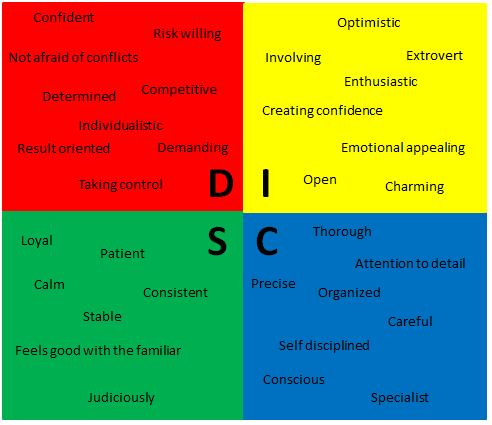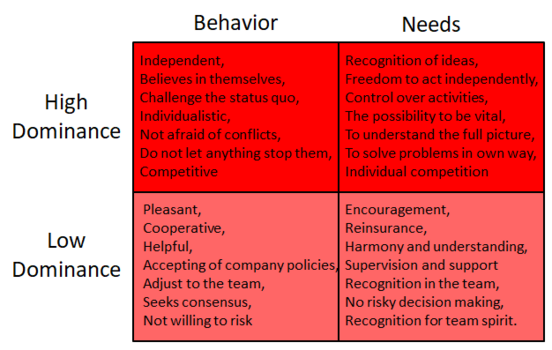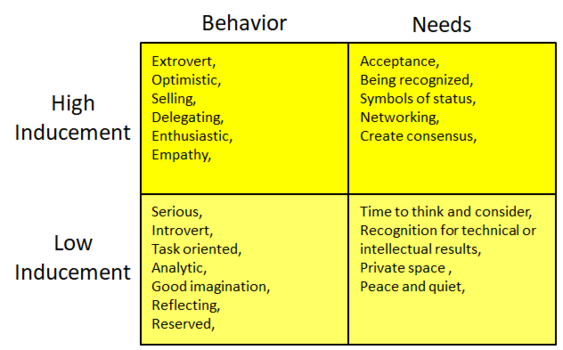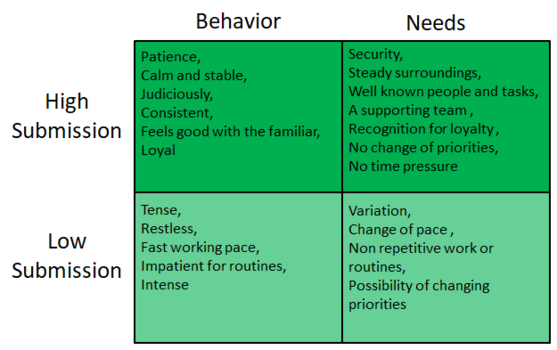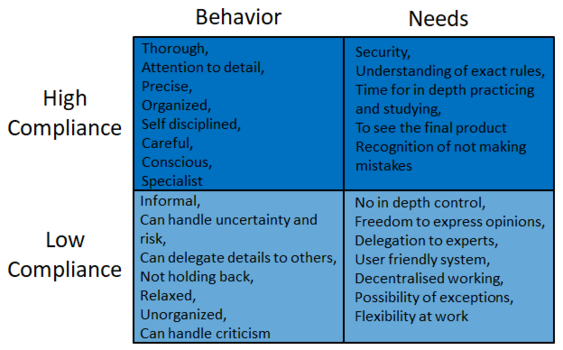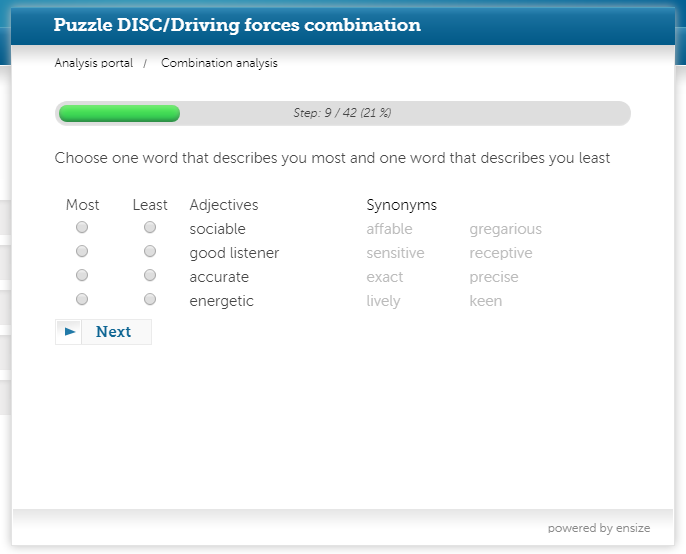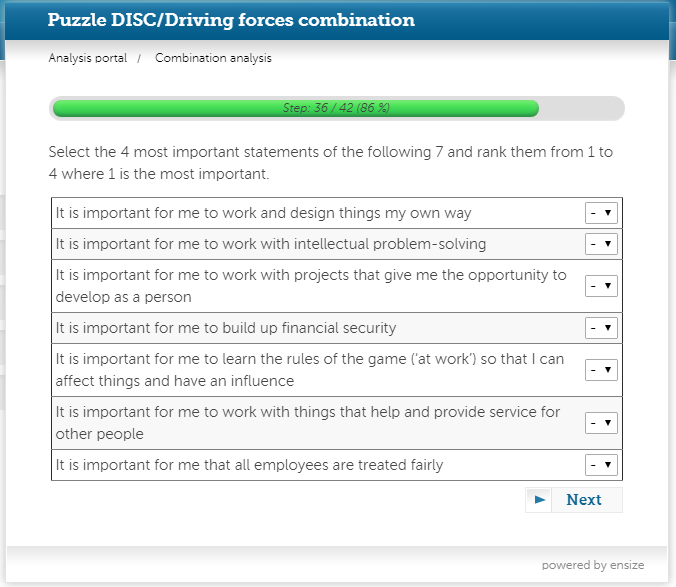Management with DISC profile analysis
Developed by Nanna Basa
Contents |
Abstract
DISC (Dominance, Inducement, Submission, Compliance) analysis is a strategic tool for evaluating behavior often used internally in an organisation by managers to improve group dynamics and the well-being of the individual. DISC is a very simple and easy to use tool for improving relations, resolving conflicts, enhances motivation, and supports self-growth by obtaining a better understanding of the individual’s personality. Misunderstandings happen daily and can lead to stress, unhappiness and low working effort. DISC was created by psychiatrist and professor William Moulton Marston, who believed all humans have psychological motives but they differ from human to human. The tool assesses the level of Dominance, Inducement, Submission, and Compliance an individual possesses by referencing the norm. [1].
Relevance & Application
The relevance and application of the tool can be extremely broad. Wherever and whenever human interactions take place, synergies or tensions unfold. DISC analysis can be a tool for smoothing human relations if it is used right. In the workplace, the tool can be used by all levels of managers and employees working on a project, program or portfolio basis. For example, a management team that know each others DISC profiles can communicate better, shorten the time of their meetings, and prevent misunderstandings when they have the knowledge of the individuals behavioral profile. On the other hand, a manager can improve the well-being, communication, and working effort of the team. Developing the project team is a process of improving competencies, interaction between team members and the environment. On the figure below, the flow of inputs, tools and techniques, and outputs of developing project team are illustrated. Interpersonal skills, Recognition and rewards and Personnel assessment tools under Tools and Techniques all come into play with management with DISC profile analysis. [2] [3]

The DISC profile is a personal assessment tool and will let the manager know parts of own and team members interpersonal skills. Furthermore, the profiles will also indicate preferences of recognition. DISC is an easy tool for a manager to acquire the resources necessary to develop effective project teams.
This article will be focusing on the usage of DISC behavioral profile analysis as tool for develop project team.
Firstly, an introduction to the tool is given including the theory of the DISC model and its background. This is followed by the method of use including analysis and results. Implementation of results is outlined with concrete communication strategies for the different personal profiles. Finally, benefits and limitations are discussed.
Introduction
The DISC Model Theory
The DISC personality profile is strictly a measure of the individuals perception of themselves. All profiles are equally as good. The test results describes some of the psychological drivers which affects the behavior. The general rule: Different = Different and not Different = Wrong
It assesses the behavioral level of the four traits Dominance (D), Inducement (I), Submission (S) and Compliance (C). Different variations of the DISC letters exist such as Inducement/Influence, Submission/Steadiness, and Compliance/Conscientiousness. However, the overall interpretation is the same. In the figure below the different characteristic is shown. DISC can be considered as a “color palette of personality” where every person has their own unique blend. It is possible but highly unlikely to only have one of the four traits. Usually it is a combination. [5] [6] [7]
Dominance (D)
The behavioral trait of Dominance is characterized as seeing challenges and seeking to overcome them. People with a high D are characterized as confident, risk willing, determined, result oriented and demanding. They focus on shaping their surroundings to produce the outcome of the desired results. These people desire to have power and authority, take on challenges, get direct answers, have the liberty of no control or rules, make changes, and new activities and the possibility of individual performance. The primary motive is taking control and be in charge and their major fear is losing control. They can be limited in lacking thoughts of others, being impatient, and lacking focus on quality. [8]
Inducement (I)
The trait of Inducement is perceived as extrovert and the aspiration of social interaction with others. People with a high level of Inducement seek friendly and favorable environments where they can have an impact in collaboration with others. In addition, they will try to influence and convince others. They focus on creating results by convincing and including others in a team work. The characteristics are optimistic, creating confidence, emotional appealing, involving themselves in others, extrovert, enthusiastic, charming, and open. Furthermore, they desire to be popular, being the center of attention, being praised, group activities, having positive relations, and having the freedom of no control or details focus. The primary motive is to receive recognition from others and they fear social rejection. Their limitations are being impulsive, unorganized, over promising under delivering, and lacking of follow through. [9]
Submission (S)
Profiles with a high Submission score seeks to conserve the surrounding working environment and keeping it stable. They focus on solving tasks in collaboration with others. Their characteristics are judiciously, reliable, collaboration oriented, patient and listing, loyal, caring for the group, and accepting. Their desires are authentic appreciation, collaboration, using known methods and procedures in their work, stability, and time when necessary to adapt to changes. Their primary motive is stability and they fear changes and unexpected events. Their limitations are putting others needs first and resistance against positive changes. [10]
Compliance (C)
The trait of Compliance is considered the urge for formalities, rules and structure. The behavioral characteristics are seeking to work within established rules and guidelines to ensure high quality and accuracy. People with a high level of Compliance focus on working under known conditions and to improve the quality of products and services. They are analytical and fact oriented and have awareness of standards and pay attention to details. Furthermore, they are very conscious, diplomatic, reliable and careful, and can often be a bit reserved. Their desires are being right, having complete overview, being praised for their tasks, limit risks, the possibility of leaning on authorities. The primary motive is to ensure quality and accuracy as they fear mistakes, sloppy methodology, criticism of their work and emotional situations. Limitations are very self critical, indecisive, and lack of creativity. [11]
Background
The history of the four quadrants DISC personality profile can be traced all the way back to Empodocles four elements of fire, earth, air and water in 450 B.C. Empodocles observed people seemed to behave in four different ways due to external environmental factors. 50 years later, Hippocrates redefined these as four internal factors called the four temperaments: choleric, sanguine, phlegmatic, and melancholic. Many years later, the theory was advanced further by Carl Jung where in 1921, Jung reconfirmed personality traits were internal and attributed the differences to how people think. Jung saw these four differences as: thinking, feeling, sensation and intuition. Today, these are often used in Myers Briggs Personality Test (MBTI).
The DISC personality was manifested in 1928 when William Moulton Marston published his book with the title “Emotions of Normal People”. The main principles of DICS have their roots in the book. Marston believed people’s daily behavior stems from their predictable characteristics. Their behavior was not only seen as internal but also influenced by the external environment. Marston defined the personality trait as: Dominance, Influence, Steadiness and Compliance. Based on Marston’s theory Walter Clark developed the DISC personality profile in 1940 which is widely used today. [12] [13] [14]
Method of use
Goals of Management with DISC
As a manager using the DISC profile analysis tool it should be sought to:
- Understand one's own behavioral traits and tendencies and develop an understanding of how one's own behavior affects others.
- Understand, respect, and value the individual differences on the team.
- Develop strategies to improve cooperation.
- Improve effectiveness in operations by advancing the relations with team members.
The Analysis
A DISC personality profile is created by answering a questionnaire about the person’s behavior in various situations. The answers are subjective as the individuals are considered being experts on themselves.
The analysis is based on self-reflecting. When completing the analysis, the participant should picture themselves in a normal work situation. The analysis takes 15-25 minutes and consists of two parts:
- The Most and Least option for a group of 4 adjectives. In total there are 28 words to be considered. The 4 adjectives are proposed as main words and if unsure synonyms are giving as help.
- The Driving Forces Analysis part contains 6 questions with 7 statements each. The 4 most important statements in each question are ranked from 1 to 4 where 1 is the most important.
The individual options chosen are confidential and not visible to anyone, it is only the combined results of these options that are presented in the personal report made. [17]
Results
The analysis produces a profile report of 35 pages of the individual behavioral style, tendencies, needs, preferred environment and strategies useful for optimal behavior. Furthermore, it also provides insights into the strength and weaknesses of the individual. The DISC personality profile report evaluates the level of contribution of each of the four traits Dominance, Inducement, Submission, and Compliance. As seen on the figure below the analysis provides an overview of the basic behaviour and the adopted behavior.

The basic behaviour shows the natural behavior and the adapted behaviour reflects the changes the person feels is needed in order to fit into situations. The report results gives a description to the personal profile of:
- What is natural
- What motivates
- How organising and planning is done
- How decisions are made
- How communication with others is done
- The consequence of the way of communication
- The value to an organisation
- Information for the manager on how to strengthen relationship
- How to increase efficiency in terms of types of needs and surrounding people
- The personal qualities
- How to approach difficulties and challenges
- How to communicate thoughts and ideas
- The response to the pace of surroundings
- The response to rules and procedures
Implementation of Results
With access to the full report the manager can gain a very thorough analysis of the team members. This can be vital for the right support, collaboration, and communication. Proactive measures can be taken by managers to place people according to their preferences of environment to help them feel comfortable and empowered. When approaching people, it can be done in a way that creates a positive response. It is widely believed in the community of psychologists that traits and situations are interactive. DISC can help managers adopting their responses based on the DISC profile of team members. This means managers should not always choose to use the behaviors that are the most comfortable for them and instead choose the behaviors that would be the most successful within the team.
Firstly the manager understands own behavioral traits and tendencies and have developed an understanding of how one's own behavior affects others. Secoundly the manager must understand, respect, and value the individual differences on the team. Next is how to develop strategies to improve cooperation.
Questions to be asked are:
- How do the manager and the team members best communicate?
- How does the manager gain the trust of confidence of the team members?
- What concrete measures can the manager take in order to make the individual team members feel the most comfortable?
The manager can find most of these answers in the individual reports. When implemented correct the manager should be able to improve effectiveness in operations by having advanced the relations with team members. The following table provides an overview of how a manager should communicate with the team members of a high level of Dominance, Inducement, Submission, Compliance:
| Manager's Communication Strategy with Team Members DISC Profiles [20] |
|---|
|
Dominance Profile
|
|
Inducement Profile
|
|
Submission Profile
|
|
Compliance Profile
|
Benefits
Various tools for personnel assessment are available such as attitudinal surveys, specific assessments, structured interviews, ability tests, and focus groups. They can give better understanding, trust, commitment, and communications among team members and facilitate more productive teams. As a personnel assessment tool, DISC analysis provides a project manager and their team with knowledge about strengths and weaknesses. The manager can evaluate preferences of the team, on what grounds they make decisions and how they interact with people. Furthermore it can enhance communication and improve effectiveness as a result.
The tool can be beneficial as a strategic tool on individual, team and organizational levels. It can be applied on various needs of the company aspects of:
- Recruiting
- Individual assessment
- Management development skills
- Talent spotting
- Optimization of teams and management groups
- Organizational development
- Change management
The questionnaire is web-based and fast to answer. It is an international tool and translated into many languages making it highly applicable for global companies. It provides concise, clear and simple profile analysis. It is extremely straight forward and simple for a manager to learn and implement. Concrete measures for the individual team members are provided in the analysis report. [21] [22]
Limitations
- The analysis does not measure all aspects of the personality
- The analysis is subjective. What you think of yourself is not always the reality or how you are perceived by others.
- Only behavioural tendencies are shown and it does not take the individuals values into consideration. If a person's values are at stake it can cause a different reaction than according to the DISC profile.
- When completing the analysis, the least and most used options are not necessarily applicable and it can be hard to choose since behavior is flexible and dynamic and it can vary from situation to situation.
Annotated Bibliography
- Marston, W. M., (1928), Emotions of Normal People, Kegan Paul Trench Trubner And Company
Provides insights into the driving forces of human beings and the fundamentals of the DISS theory. Describes Dominance, Inducement Submission, and Compliance.
- Project Management Institute, (2013), A Guide to the Project Management Body of Knowledge, Project Management Institute, Fifth Edition
Provides the fundamentals of project management. Project Human Resource Management is described in chapter 9 and section 9.3 is specific about develop project team.
References
- ↑ Marston, W. M., (1928), Emotions of Normal People, Kegan Paul Trench Trubner And Company
- ↑ Project Management Institute, (2013) A Guide to the Project Management Body of Knowledge, Project Management Institute, Fifth Edition
- ↑ Oschadleus, J. (2010), Tanks, snipers and grenades: discover techniques for dealing with annoying communicators. Paper presented at PMI® Global Congress 2010—Asia Pacific, Melbourne, Victoria, Australia. Newtown Square, PA: Project Management Institute
- ↑ Project Management Institute, (2013) A Guide to the Project Management Body of Knowledge, Project Management Institute, Fifth Edition
- ↑ www.discprofile.com
- ↑ www.discinsights.com
- ↑ www.peoplekeys.com
- ↑ Marston, W. M., (1928), Emotions of Normal People, Kegan Paul Trench Trubner And Company
- ↑ Marston, W. M., (1928), Emotions of Normal People, Kegan Paul Trench Trubner And Company
- ↑ Marston, W. M., (1928), Emotions of Normal People, Kegan Paul Trench Trubner And Company
- ↑ Marston, W. M., (1928), Emotions of Normal People, Kegan Paul Trench Trubner And Company
- ↑ www.discprofile.com
- ↑ www.discinsights.com
- ↑ www.peoplekeys.com
- ↑ www.sapiens.nu
- ↑ www.sapiens.nu
- ↑ www.sapiens.nu
- ↑ www.sapiens.nu
- ↑ www.sapiens.nu
- ↑ www.sapiens.nu
- ↑ Project Management Institute, (2013) A Guide to the Project Management Body of Knowledge, Project Management Institute, Fifth Edition
- ↑ Oschadleus, J. (2010), Tanks, snipers and grenades: discover techniques for dealing with annoying communicators. Paper presented at PMI® Global Congress 2010—Asia Pacific, Melbourne, Victoria, Australia. Newtown Square, PA: Project Management Institute
